St. Louis is often referred to as the Gateway to the West. This is because it is a vibrant and historic city nestled in the heart of the United States. Located in the state of Missouri, this city has a lot of rich history as well as diverse culture, iconic landmarks, and unique geographical features.
Where is St. Louis Located on the Map?
St. Louis is located in Missouri, which is a landlocked state in the central part of the United States. Situated near the confluence of the Mississippi River and the Missouri River, it lies in a strategic position that historically made it a hub for trade and transportation. The city lies in the eastern part of Missouri, approximately 190 miles southwest of Chicago, Illinois, and about 300 miles northwest of Nashville, Tennessee.
How Far Is St. Louis from Other Major Cities in Missouri?
Here is a table displaying the approximate distances from St. Louis to other major cities in Missouri:
| City | Distance from St. Louis (miles) |
|---|---|
| Kansas City | 249 |
| Springfield | 215 |
| Columbia | 123 |
| Jefferson City | 127 |
Is St. Louis a Good Place to Live?
St. Louis has a lot to offer both residents and visitors. It is famous for being affordable, for its diverse neighborhoods, and having a strong sense of community. The city also has a rich cultural scene with numerous museums, theaters, and music venues. Additionally, the cost of living in the city is generally lower than in many other major U.S. cities, which makes it an attractive destination for families, young professionals, and retirees. However, like any city, St. Louis has its challenges, which includes crime rates in certain areas. However, overall, it’s a great place to live. Prospective residents should definitely research neighborhoods carefully to find the right fit for their lifestyle and priorities.
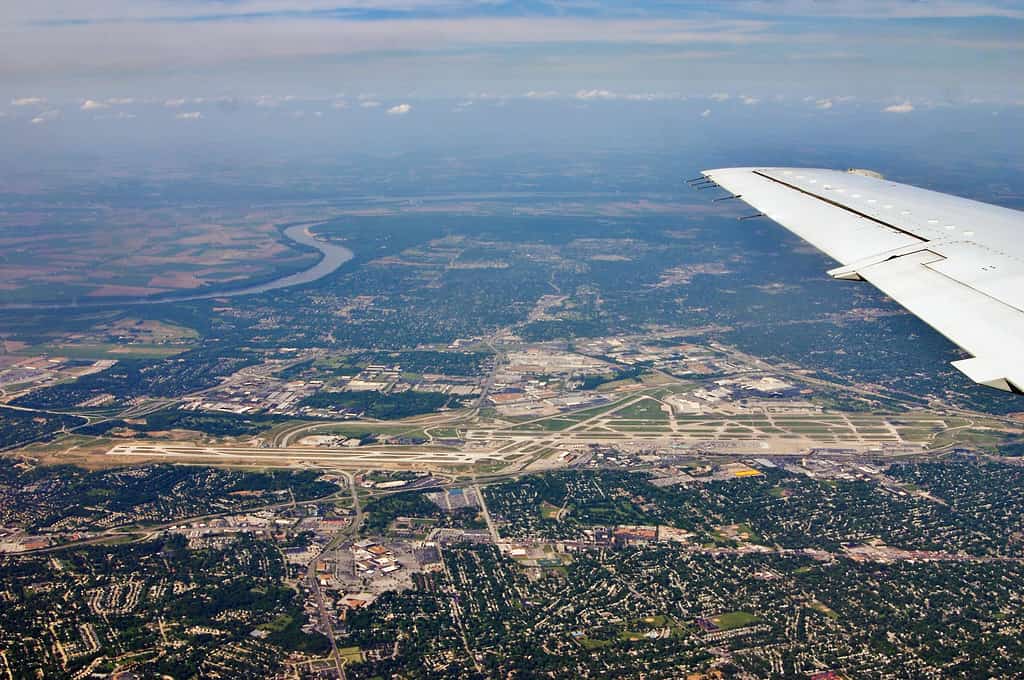
St. Louis is one of the busiest cities in Missouri.
©© Mitch Aunger/iStock via Getty Images
What is St. Louis Famous For?
St. Louis is famous for having a diverse array of cultural, historical, and culinary aspects that have left an indelible mark on the city’s identity. Let’s dive deeper into what makes it a renowned and celebrated destination:
Gateway Arch
The Gateway Arch is perhaps the most iconic symbol of St. Louis. It has a height of 630 feet (192 meters). It commemorates the city’s historical role as the Gateway to the West during the westward expansion of the United States. Designed by renowned architect Eero Saarinen, this stainless steel monument is not only an architectural marvel but is also an important symbol of American history. Visitors can also ride a tram to the top for breathtaking views of the city and the Mississippi River.
Baseball Tradition
The culture of St. Louis is also famous for its connection to baseball. The city is also famous for its passionate fan base and storied baseball tradition. The St. Louis Cardinals, one of the oldest and most successful Major League Baseball franchises, call the city their home. The team also has a rich history of success, winning numerous World Series championships. The atmosphere at Busch Stadium, the Cardinals’ home ballpark, has an electric atmosphere during games, making it a must-visit for sports enthusiasts.
Cultural Attractions
St. Louis also has a treasure trove of cultural attractions that cater to a wide range of interests. Located in Forest Park, the St. Louis Art Museum is a world-class museum boasts an extensive collection of art from various cultures and time periods. To delve into the history of the city and the state of Missouri through engaging exhibits and artifacts, visitors should go to the Missouri History Museum. St. Louis is also famous for its symphony orchestra. It has several exceptional performances all year round, drawing music enthusiasts from far and wide. Known as America’s oldest and largest outdoor musical theater, The Muny also presents spectacular Broadway-style shows during the summer season.
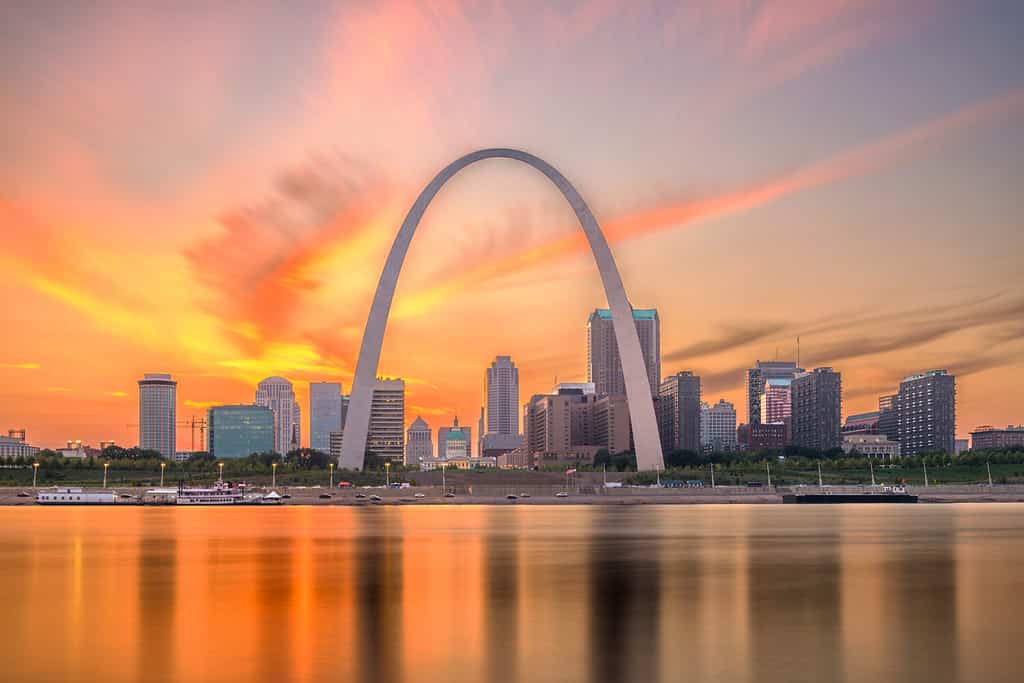
St. Louis’s downtown cityscape on the river at dusk. It has several beautiful buildings.
©Sean Pavone/Shutterstock.com
Culinary Delights
St. Louis has a distinct culinary scene that has given rise to unique and delicious dishes. Known for its thin, cracker-like crust and square slices, St. Louis-style pizza is a local favorite. Provel cheese, a blend of provolone, Swiss, and cheddar, is a signature topping. Toasted ravioli, which are breaded, deep-fried ravioli pockets, combined with marinara sauce make some of the best appetizers in the city.
Gooey butter cakes are delectable desserts that originated in St. Louis. They are a sweet, rich treat that have become a local icon. Finally, St. Louis also has a thriving craft beer scene, with numerous breweries offering a wide range of unique and flavorful beers.
Historic Neighborhoods
St. Louis is also famous for its charming historic neighborhoods, each with its own unique character. Soulard is a historic district famous for its vibrant nightlife, historic architecture. The Soulard Farmers Market is one of the oldest farmers’ markets in the country. Lafayette Square has beautifully restored Victorian homes and picturesque park. It is also a gem for architecture and history enthusiasts. Finally, a neighborhood with strong Italian roots, The Hill is famous for its authentic Italian cuisine, family-owned restaurants, and welcoming atmosphere.
Contributions to Music
St. Louis has also left a mark on the world of music. St. Louis played a pivotal role in the development of ragtime music, with notable figures like Scott Joplin composing some of the genre’s most iconic pieces. The legendary rock ‘n’ roll pioneer, Chuck Berry, also hails from St. Louis. His influence on the music industry is immeasurable.
Historic Events
St. Louis has hosted several historic events that have garnered national and international attention. One of those events is the 1904 World’s Far. St. Louis hosted the 1904 World’s Fair, which showcased cutting-edge technology and innovation of the time. The fair is also famous for introducing the ice cream cone and Dr. Pepper to a wide audience. The first non-stop transatlantic flight flew from St. Louis to Ireland in 1923 by Charles Lindbergh, who later became an international aviation hero.
The Geography of St. Louis
St. Louis, Missouri, lies in a region of diverse and fascinating geography that has also played a significant role in shaping the city’s character and development. Let’s explore the geographical features that define the landscape of St. Louis:
Confluence of Rivers
One of the most defining geographical features of St. Louis is its location at the confluence of two major rivers—the Mississippi River and the Missouri River. This confluence has historically made St. Louis a crucial hub for trade and transportation. The Mississippi River flows from north to south and separates St. Louis from the state of Illinois to the east. Meanwhile, the Missouri River flows from the west and joins the Mississippi just north of the city. The meeting of these two rivers has not only shaped the city’s history but also its topography.
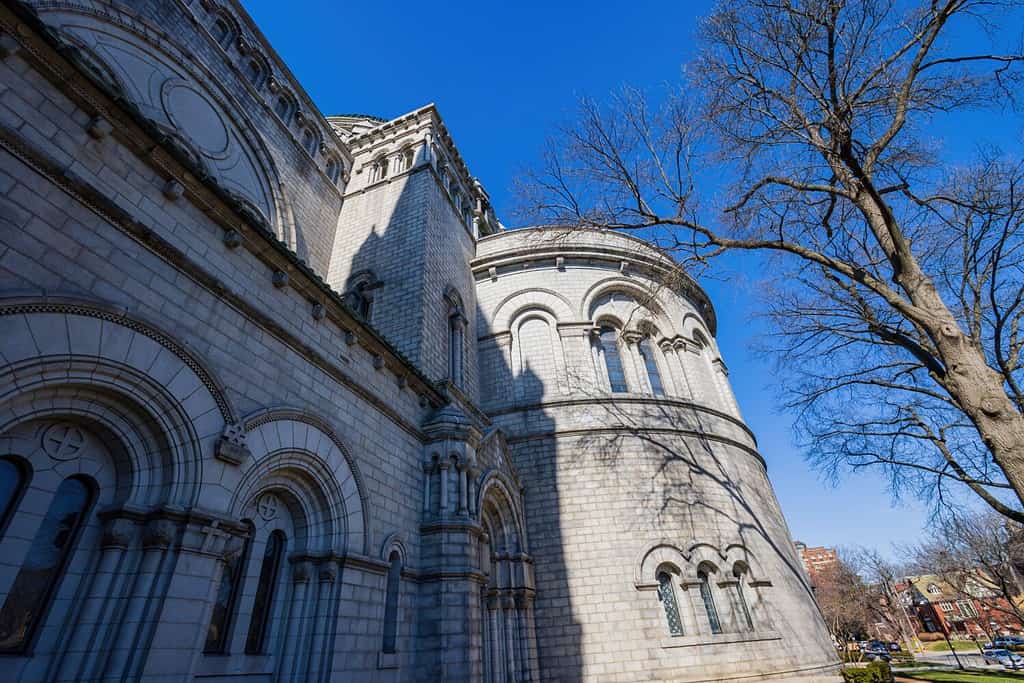
The Cathedral Basilica of Saint Louis in St. Louis, Missouri was consecrated in 1926.
©Kit Leong/Shutterstock.com
Topography and Elevation
St. Louis’s topography has diverse terrain, which varies from flat riverbanks to rolling hills and elevated bluffs. The city’s elevation varies significantly, with the downtown area located near the banks of the Mississippi River at a relatively low elevation. As one moves westward and southward, the land gradually rises in elevation. Some of the city’s western suburbs and neighborhoods are situated at higher elevations. These can exceed 900 feet (275 meters) above sea level. These hills and bluffs add depth and character to the city’s landscape, offering stunning views of the surrounding areas.
Parks and Green Spaces
St. Louis has an abundance of parks and green spaces that provide residents and visitors with opportunities for outdoor recreation and appreciation of nature. Forest Park, one of the city’s crown jewels, encompasses 1,371 acres (554 hectares) and is larger than New York City’s Central Park. Forest Park offers a mix of woodlands, lakes, gardens, and cultural institutions, making it a cherished natural and cultural resource.
Forests and Woodlands
While St. Louis is a metropolitan area, it is surrounded by lush forests and woodlands. The city is in proximity to various state and national forests, such as the Mark Twain National Forest to the south. This provides ample opportunities for hiking, camping, and wildlife observation. These forests are also home to a variety of tree species, including oak, hickory, and maple, which contribute to the region’s vibrant fall foliage.
Proximity to the Ozark Plateau
St. Louis is also located relatively close to the Ozark Plateau, a highland region known for its rugged terrain, rolling hills, and karst landscapes. While the city itself is not within the Ozarks, residents and visitors can easily access this natural spot for outdoor adventures such as hiking, caving, and exploring spring-fed rivers.
Urban and Suburban Mix
The city’s geography also includes a blend of urban and suburban environments. St. Louis encompasses the more densely populated urban core. Meanwhile, numerous suburbs and municipalities extend into the surrounding counties, which have a mix of residential, commercial, and green spaces.
What Is the Climate in St. Louis?
St. Louis also experiences a dynamic climate with four distinct seasons that offer residents and visitors a wide range of weather experiences.
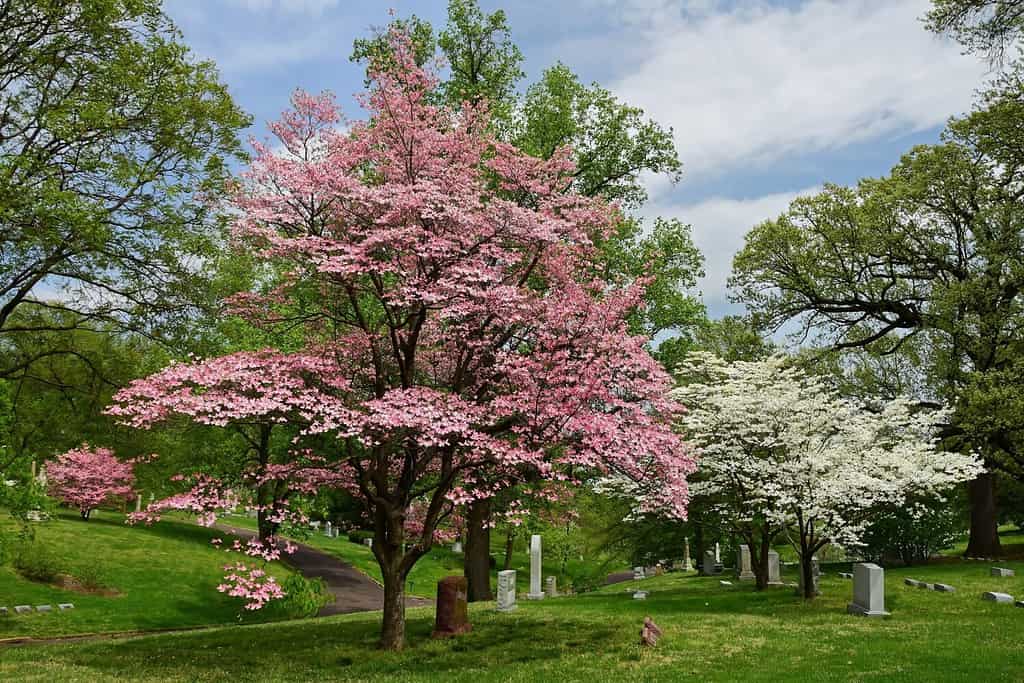
Beautiful flowering white and pink dogwood flowers in spring in the public gardens of Bellefontaine Cemetery in North St. Louis, Missouri.
©Nina B/Shutterstock.com
Summers in St. Louis are really characterized by high temperatures and humidity. Daytime temperatures often surge around 90°F (32°C), creating a sultry and sweaty atmosphere. The city’s residents also have to cope with sweltering days and warm, balmy nights. Thus, they seek relief in air-conditioned spaces, pools, and local water parks. Thunderstorms are also a common occurrence during these months, providing temporary relief from the heat but sometimes resulting in heavy downpours and localized flooding.
As autumn arrives, St. Louis’s weather undergoes a delightful transformation. The oppressive heat of summer gives way to milder temperatures, typically ranging from around 70°F to around 60°F. The most picturesque aspect of fall in the city is the vibrant display of foliage. This is because during fall, trees have their brilliant red, orange, and golden hues. The city’s parks and nearby forests become popular destinations for hiking and enjoying the breathtaking scenery. With lower humidity levels, this season is often considered the most pleasant for outdoor activities.
Winter in St. Louis brings in colder temperatures, with daytime highs around 30°F (below 0°C) to around 40°F. While snowfall varies from year to year, residents can expect at least some snow during the season. Occasionally, freezing rain and ice storms can make travel treacherous. Despite the chill, the city still has much to offer during this season, from holiday festivities to indoor cultural events.
Wildlife in St. Louis
St. Louis, despite being a bustling metropolitan area, has a surprising diversity of wildlife within its urban and suburban environments. The presence of parks, green spaces, and nearby waterways creates a variety of habitats that support a wide range of species.
Birdlife
St. Louis is part of the Mississippi Flyway, one of the major migration routes for birds in North America. This geographical advantage makes the city a haven for birdwatchers. Throughout the year, numerous species of migratory birds pass through or reside in the area, including waterfowl, songbirds, raptors and great blue herons.
St. Louis’ numerous lakes, ponds, and rivers attract a variety of waterfowl, such as ducks, geese, and swans. The city’s parks and green spaces are also filled with the melodies of songbirds like sparrows, finches, and warblers. Hawks, eagles, and even peregrine falcons often soar over the city’s skies. Meanwhile, great blue herons, which are majestic wading birds, are present along the banks of rivers and ponds.
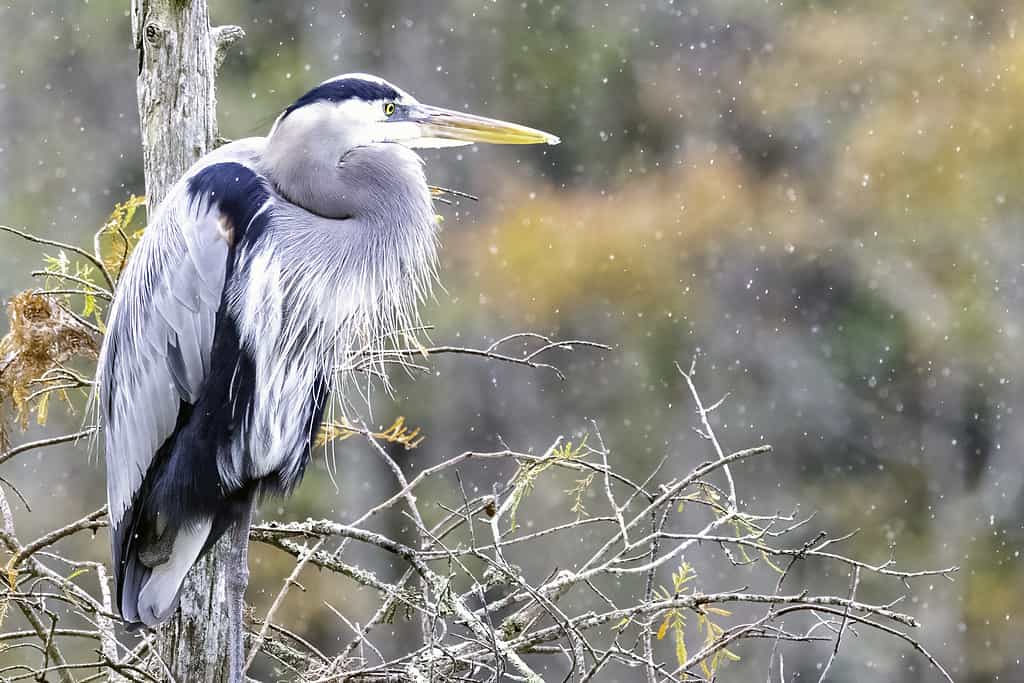
Great Blue Herons have powder down feathers that help repel the rain.
©dangarneau/iStock via Getty Images
Mammals
St. Louis is home to a surprising number of mammals that have adapted to urban and suburban environments. The white-tailed deer, which are these graceful creatures with long antlers, often roam in suburban areas and parks, where they graze in open spaces. Agile and adaptable, eastern grey squirrels are also a common sight in city parks and neighborhoods. Raccoons are clever mammals, famous for their adaptability and often rummage through trash cans in search of food. Although typically elusive, coyotes have also been known to venture into urban areas, especially during twilight hours.
Amphibians and Reptiles
St. Louis’s mix of wetlands, ponds, and forests provides suitable habitats for amphibians and reptiles Eastern box turtles are these slow-moving turtles, who are native to the region and are often spotted in woodlands and grassy areas. Green frogs and bullfrogs are also present in wetlands and ponds around the city. They are home to a variety of frog species, with their distinctive calls being heard during the warmer months.
River Wildlife
The city’s proximity to the Mississippi River and its tributaries supports a unique aquatic ecosystem. St. Louis is known for its excellent catfishing opportunities, and various catfish species thrive in the area’s rivers. Largemouth and smallmouth bass are also popular catches in the rivers and lakes around the city. Although once rare in the area, river otters have once again made a comeback and can occasionally be spotted in the waterways.
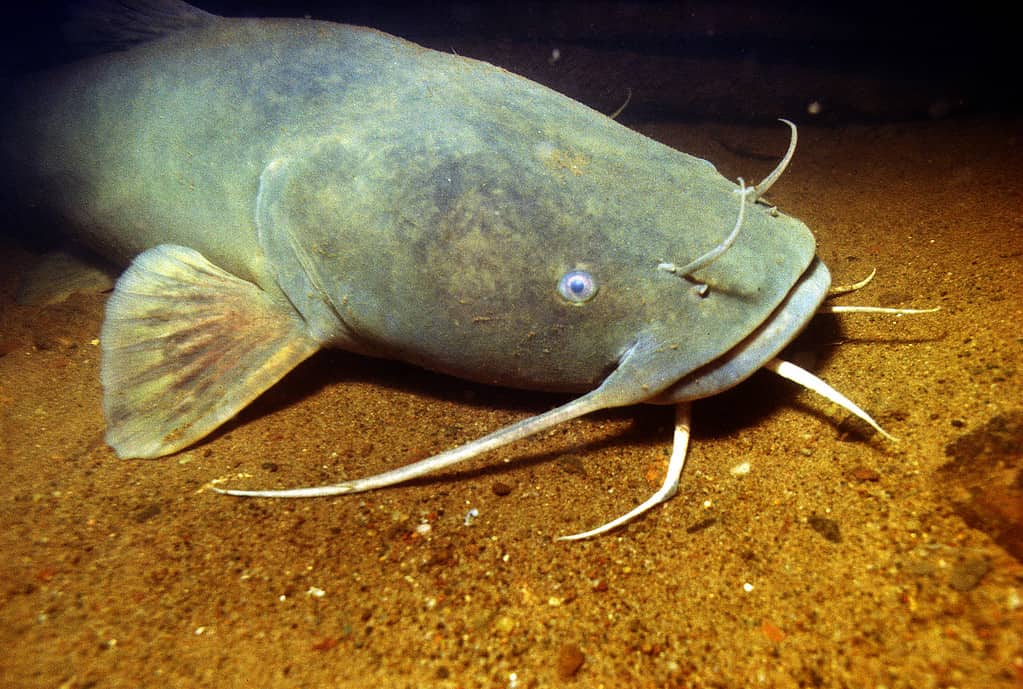
Flathead catfish on bottom of the Mississippi River near St. Louis.
©stammphoto/ via Getty Images
Urban Gardens and Pollinators:
Community gardens and green spaces within the city also provide crucial habitats for insects like bees, butterflies, and other pollinators. These spaces are essential for supporting local flora and providing opportunities for city residents to engage with nature.
In conclusion, St. Louis, Missouri, is a city surrounded by history and renowned for its diverse culture, iconic landmarks, and unique geographical features. Its geographical position at the confluence of major rivers, its pleasant climate, and its thriving wildlife make it a fascinating place to live or visit. Whether you’re drawn to its cultural attractions, its natural beauty, or its sports scene, St. Louis has something to offer to you.
The photo featured at the top of this post is © © Mitch Aunger/iStock via Getty Images
Thank you for reading! Have some feedback for us? Contact the AZ Animals editorial team.






